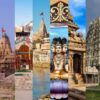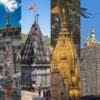Things to Do in Kashmir.
1. Visit Srinagar’s Dal Lake
Things to Do: Dal Lake is the most iconic attraction in Srinagar. You can take a shikara (boat ride) on the lake, visit floating gardens, and stay in a traditional houseboat. The lake is surrounded by snow-capped mountains, offering a mesmerizing view.
Best Season: The best time to visit Dal Lake is during spring (March to May) when the weather is pleasant, and the floating gardens are in full bloom.
2. Explore the Mughal Gardens
Things to Do: Kashmir is home to several Mughal-era gardens known for their beauty and landscaping. Popular gardens like Shalimar Bagh, Nishat Bagh, and Chashme Shahi offer serene surroundings and historical significance.
Best Season: The best time to visit is spring and summer (March to June), when the flowers are in full bloom.
3. Go Skiing in Gulmarg
Things to Do: Gulmarg is one of India’s most popular skiing destinations. The snow-covered slopes offer excellent conditions for skiing, snowboarding, and other winter sports.
Best Season: The best time to visit for snow sports is winter (December to February), when the area is blanketed with snow.
4. Trek to Sonamarg
Things to Do: Known as the “Meadow of Gold,” Sonamarg is a paradise for trekkers. You can enjoy treks to places like Thajiwas Glacier, Srikhand Peak, and other offbeat spots in the area.
Best Season: May to October is ideal for trekking, as the weather is pleasant and the trails are accessible.
5. Visit the Amarnath Cave Temple
Things to Do: The Amarnath Cave Temple, dedicated to Lord Shiva, is one of the most revered pilgrimage sites in India. Pilgrims travel to the cave during the Amarnath Yatra in the summer months.
Best Season: The best time to visit is during the summer months (June to August) when the Amarnath Yatra takes place, although the weather is generally good for visiting year-round.
6. Explore Pahalgam
Things to Do: Pahalgam is a picturesque town known for its scenic beauty, tranquil rivers, and lush green meadows. You can enjoy horseback riding, trekking, or simply relax by the Lidder River.
Best Season: The best time to visit Pahalgam is April to October when the weather is comfortable, and you can enjoy outdoor activities.
7. Visit the Shankaracharya Temple
Things to Do: This ancient temple is located on a hilltop and offers panoramic views of the entire city of Srinagar and Dal Lake. The temple is dedicated to Lord Shiva and is an important pilgrimage site.
Best Season: The ideal time to visit the Shankaracharya Temple is April to September, when the weather is conducive for trekking and sightseeing.
8. Experience the Kashmiri Cuisine
Things to Do: Kashmiri cuisine is unique and flavorful, with dishes like Rogan Josh, Gushtaba, Yakhni, and Kahwa (a traditional Kashmiri tea). Don’t miss trying a traditional Wazwan meal, which is a royal multi-course feast.
Best Season: The best time to enjoy Kashmiri cuisine is during your stay, but winter months, when locals enjoy hot, spicy food, are particularly suitable.
9. Visit Betaab Valley
Things to Do: Located near Pahalgam, Betaab Valley is known for its lush green meadows, rivers, and views of the snow-covered mountains. It is an ideal place for picnics, nature walks, and photography.
Best Season: Summer months (April to June) are ideal for visiting Betaab Valley due to the pleasant weather and green landscape.
10. Visit the Hazratbal Shrine
Things to Do: The Hazratbal Shrine is a significant Muslim religious site in Srinagar. It is located on the northern banks of Dal Lake and offers a peaceful atmosphere. The shrine houses a relic believed to be the hair of the Prophet Muhammad.
Best Season: April to October is the best time to visit the shrine, as the weather is favorable for a peaceful visit.
11. Enjoy Shikara and Houseboat Stay on Nigeen Lake
Things to Do: Nigeen Lake, less crowded than Dal Lake, offers a peaceful environment for shikara rides and houseboat stays. It’s a quieter option for tourists seeking tranquility.
Best Season: The best time to visit Nigeen Lake is during spring and summer (March to June).
12. Take a Gondola Ride in Gulmarg
Things to Do: The Gulmarg Gondola is one of the highest cable car rides in the world. It offers stunning views of the snow-covered mountains, making it a popular activity.
Best Season: The best time to take the gondola ride is during winter (December to February) for snow views, but the gondola operates year-round.
Best Seasons to Visit Kashmir
Kashmir has distinct seasons, each offering unique experiences. Here’s an overview of the best time to visit based on what you want to do:
Kashmir is a year-round destination, but the best time to visit depends on the type of experience you’re looking for. The summer months (May to September) are perfect for sightseeing, trekking, and houseboat stays, while winter (December to February) is the best for skiing and snow sports. Kashmir offers an unforgettable blend of natural beauty, culture, and adventure, making it a must-visit destination in India.





